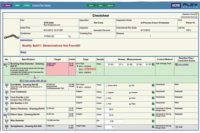Manufacturers today understand the importance of an innovative, flexible and skilled workforce that is enabled by technology to make fast and efficient decisions and recognize and take advantage of new opportunities. While the goal of technology in the manufacturing environment is uniting the shop floor and the top floor for improved operational visibility, decision making and performance, the manufacturing environment has to date been a house divided.
Traditionally, operational visibility in the realm of the shop floor has been provided by Manufacturing Execution Systems (MES) supporting real-time process control scenarios and quality initiatives, whereas Enterprise Resource Planning has been in use upstream in the manufacturing operations, primarily supporting optimized scheduling and planning. Each system on its own can provide myriad benefits. But today’s manufacturers aren’t willing to settle; instead, desiring to drive improved performance and competitive advantage they are integrating these two systems and these two worlds to leverage the best of both.
Evaluating ERP
ERP is no longer simply about cutting costs, but rather about enabling businesses to grow and take advantage of new opportunities and avoid unexpected risks. Companies now need the next evolution of ERP systems that can support collaboration, adapt to unique and dynamic environments, enable improved customer satisfaction and new business, and which can drive growth as well as control costs.
TECH TIPSStatistical process control (SPC) and statistical quality control (SQC) are key components of an MES system. Real-time reconciliation of information between ERP and MES ensures data integrity for supporting accurate scheduling, planning, monitoring, resourcing and costing. The integration of ERP and MES starts with a cultural change within a company. |
ERP system architectures that empower employees by uniting social, mobile, and analytic capabilities can help support innovation. Employees can then raise the individual and collective performance within the company by leveraging real-time shared access to the same repository using a set of tools that meets the specific needs and requirements of each user.
MES
Statistical process control (SPC) and statistical quality control (SQC) are key components of an MES system and allow it to function as a visual tool to help maintenance managers and shop floor managers predict when, and what kinds of, proactive efforts will help keep things running “today” and “right now” for better overall equipment effectiveness. It can offer forward-looking, better preventive maintenance, and just-in-time responsiveness can mean less downtime, less scrap, more quality product.
Top executives sometimes don’t realize they can drive significant business value from MES. While MES is often viewed as a tool to assist the shop floor in day-to-day tasks, MES systems offer ample potential to help transform the shop floor into a business center of excellence, and propel companies forward for market leadership.
MES can deliver consistent, accurate, and visible metrics. Operations management can use those metrics to identify underperforming and high-performance machines and then optimize asset utilization accordingly to eliminate bottlenecks. They can propagate best practices enterprise-wide from lessons learned. In addition, performance efficiencies gained from MES can open up the possibility of increasing output and profitability, all from existing production assets. Capital expenditures can be deferred or rerouted to fuel investments in other areas to expand and grow the business.
Better Together
While the business case is clear for both ERP and MES, what is now being revealed is the business case around leveraging the synergies of both systems. One of the common challenges manufacturing organizations face is the need to effectively connect planning and scheduling data from its ERP system with the shop floor realities of MES into one centralized system. Imagine the possibilities of having real-time access to machine data that can be imported into an ERP system to better plan schedules and resources to meet customer demand.
Doing so can help avoid the following situations that throttle manufacturing performance:
Lack of visibility: Having poor insight into shop floor operations can slow decision-making, resulting in delays and unhappy customers. Understanding the situation on the shop floor in real-time helps manufacturers to better plan to meet customer demand.
Communication bottlenecks with disparate systems: Manufacturers typically purchase ERP and MES systems from different vendors which often times leads to manually entering data from one system to another in order for both to communicate with each other. This is inefficient and costly.
Increased inventory costs: If there is a quality or maintenance issue on the floor, real-time alerts and notifications can raise a red flag, enabling immediate action to resolve the issue. On the other hand, without this real-time shop floor data access, manufacturers run the risk of higher amounts of scrap and inventory which negatively impacts the bottom line.
Through integration of ERP and MES, manufacturers can achieve a holistic view of their business processes and core production, and better utilize shop floor data crucial to improving operational efficiency and maximizing profitable manufacturing outcomes. This “one version of truth” delivers more accurate data from the shop floor (MES) to the top floor (ERP), enabling manufacturers to adjust schedules and processes based upon machine availability. This in turn leads to improved scheduling accuracy of the ERP platform.
Real-time reconciliation of information between ERP and MES ensures data integrity for supporting accurate scheduling, planning, monitoring, resourcing and costing. This integration spans structural data, job scheduling and production reporting, effectively pulling data into a seamless bi-directional information environment. Users will benefit significantly from improvements in promise-to-order, labor and equipment utilization, and business intelligence as a result of tighter integration and real-time feedback between ERP and MES. In addition, a real-time closed-loop between the business systems and the plant floor provides an accurate up-to-the-minute view of machine and production availability for improving operational effectiveness and responsiveness.
Crossing the Chasm
Before purchasing and evaluating MES and ERP systems, manufacturers need to decide in the beginning of the process what will need to be accomplished on the shop floor with each system since they will be implemented on separate timelines. However, one of the challenges manufacturers face in fully realizing the value of their investments in ERP and MES is that they are often procured and managed by two different sides of the business. Typically, a plant manager acquires the MES system and manages it while the IT and finance department purchase the ERP platform. It is important that a company’s CFO and CIO come together to understand the opportunity around the ERP/MES integration. The integration of ERP and MES starts with a cultural change within a company.
The strategy of managing manufacturing operations via point solutions is becoming increasingly ineffective as manufacturers face increased global competition and market pressures. And as manufacturers embrace Big Data, mobile and Internet of Things (IoT) technologies, new data and process integration capabilities must be added to organizations’ operations. Manufacturers need to strive to improve flow/use of data throughout the organization—from shop floor to bottom floor—now, lest they become overwhelmed and outflanked.
MES ROI can be seen through product delivery, quality management and customer satisfaction. Integrated with ERP, this leads to better planning which improves a company’s overall operations and enables the executive team to lead more effectively and better understand profit/loss to make the right decisions to grow the organization. Competition may arise anywhere, often from unfamiliar players; disruptive technologies may also change the game radically in a short time. The integration of ERP and MES offers manufacturers real advantage—and shouldn’t be overlooked as organizations seek out strategies for growth and prepare for “what’s next.”





